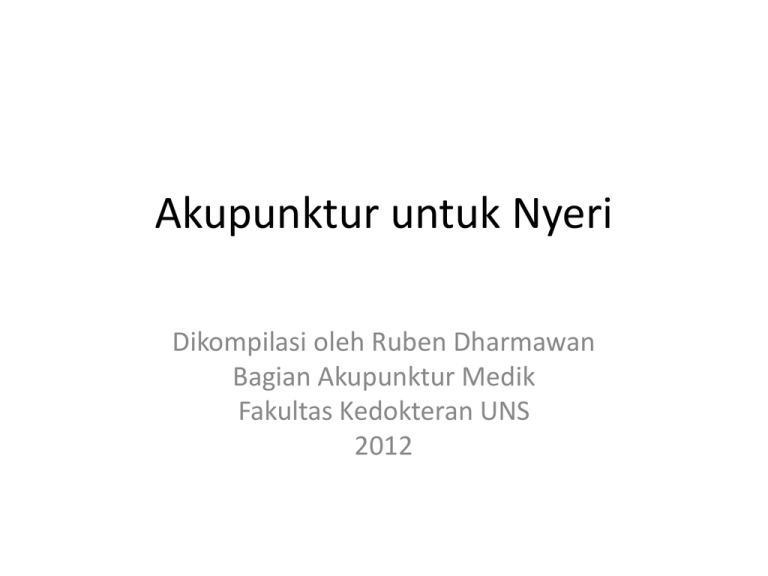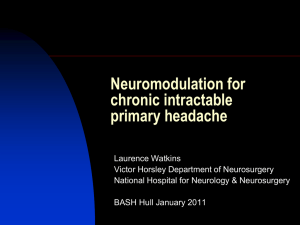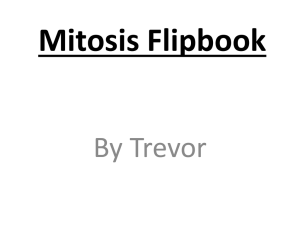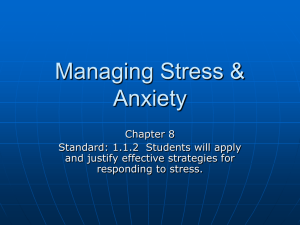Akupunktur untuk Nyeri (Kompilasi)
advertisement

Akupunktur untuk Nyeri Dikompilasi oleh Ruben Dharmawan Bagian Akupunktur Medik Fakultas Kedokteran UNS 2012 Nyeri Nyeri adalah fenomena multidimensional yang kompleks dengan sinyal nyeri disalurkan ke beberapa lokasi yang berbeda di sistem saraf. 3 (tiga) dimensi yang saling berinteraksi : 1. Sensory-discriminative 2. Cognitive evaluative 3. Motivational-affectieve Dimensi Sensory-disciminative adalah kapasitas untuk menganalisa intensitas, lokasi, kualitas dan sifat nyeri. Cognitive evaluative terkait dengan fenomena antisipasi, atensi, sugesti, pengetahuan dan pengalaman sebelumnya. Motivational-affective adalah respons emosional kuatir, takut yang mengontrol respons terhadap nyeri. Serabut aferen (kulit dan organ viscera) Nyeri dihantarkan oleh 2 (dua) macam serabut aferen : 1. Serabut Aδ, bermyelin tipis, berdiameter kecil, berkecepatan hantaran 5-30 meter/detik. Sensasinya tajam, terlokalisir dan pricking. 2. Serabut C, tidak bermyelin, berdiameter kecil, kecepatan hantaran 0,5- meter/detik. Sensasinya nyeri, difus, tumpul, tidak terlokalisir. Nyeri neuromuskuler Dapat berasal dari : 1. Komponen keras : tulang 2. Komponen lunak : otot, tendon, fasia, kapsul persendian, ligamen, pembuluh darah, berkas saraf perifer. Nyeri otot Dapat terjadi melalui 3 (tiga) mekanisme : 1. Kontraksi otot yang terlalu lama dan keras 2. Otot mengalami iskemia 3. Otot terlalu teregang lama Nyeri menurut TCM 1. Stagnasi energi, ditandai dengan peningkatan rasa nyeri bila jaringan ditekan. 2. Defisiensi energi, rasa nyeri berkurang bila jaringan ditekan. Pain Management Acupuncture, chiropractic management and physical therapy may be incorporated into pharmacologic management of pain to enhance overall well being. Palliative Care in Companion Animal Oncology Rodney L. Page MS, DVM: Diplomate ACVIM (Internal Medicine, Oncology) College of Veterinary Medicine, Cornell University Pathophysiology of Pain What is pain? An unpleasant sensory or emotional experience associated with actual or potential tissue damage, or described in terms of such damage. Pain is always subjective. Each individual learns the application of the word through experiences related to injury in early life. It is unquestionably a sensation in a part of the body, but it is also unpleasant, and therefore also an emotional experience. Many people report pain in the absence of tissue damage or any likely patophysiological cause; usually this happens for psychological reasons. (IASP. Pain 1979(6)249-252, ex Shipton, 1993) Based on clinical characteristics, inferences can be made about the predominating types of mechanisms sustaining pain. A classification based on inferred patophysiology broadly divides pain syndromes into nociceptive, neuropathic, psychogenic, mixed, or idiopathic. Nociceptive Pain Mechanisms Clinically, pain can be labeled "nociceptive" if it can be inferred that the pain is related to the degree of receptor stimulation by processes causing tissue injury. Nociceptive pain involves the normal activation of the nociceptive system by noxious stimuli. Nociception consists of four processes: transduction, transmission, perception, and modulation. Normal somatosensory processing involves interaction between afferent systems activated by tissue injury and accompanying inflammation. The primary afferent system includes nociceptors (A-delta and C- fibers), signal processing in the dorsal horn of the spinal cord, ascending neural pathways, and thalamic and other specialized brain structures. Peripheral nociceptors are lightly myelinated or nonmyelinated ends of primary afferent nociceptive (sensory neurons). Peripheral nociceptors have various response characteristics and they can be found in skin, muscle, joints, and some visceral tissues. The nociceptive process begins with transduction (depolarization) at the peripheral nociceptors in response to noxious stimuli. Transmission is the process by which these stimuli proceed along primary afferent nociceptive axons to the spinal cord and then on to higher centers. Only when the impulses reach the brain are they intellectually recognized as pain. This is perception. Nociceptive pain can be acute (short-lived, remitting) or persistent (long-lived, chronic), and may primarily involve injury to somatic or visceral tissues. Pain due to activation of somatic primary afferents is termed somatic pain and is typically localized and described as aching, squeezing, stabbing, or throbbing. Arthritis and metastatic bone pain are examples of somatic pain. Pain arising from stimulation of afferent receptors in the viscera is referred to as visceral pain. Visceral pain caused by obstruction of hollow viscus is poorly localized (because most viscera do not contain nociceptors) and is often described as cramping and gnawing, with a daily pattern of varying intensity. When organ capsules are involved, the pain may be described as sharp, stabbing or throbbing, descriptors similar to those associated with somatic pain. Nociceptive pain of any type can be referred and some referral patterns are clinically relevant. For example, injury to the hip joint may be referred to the knee and bile duct blockage may produce pain near the right shoulder blade. Pain is also distinguished by its location. Nociceptive pain may involve acute or chronic inflammation. The physiology of inflammation is complex. In addition to an immune component, retrograde release of substances from C polymodal nociceptors also may be involved. This “neurogenic inflammation” involves the release of the endogenous pain facilitory chemical known as substance P, as well as serotonin, histamine, acetylcholine, and bradykinin. These substances activate and sensitize other nociceptors. Prostaglandins produced at the site of injury act to further enhance the nociceptive response to inflammation by lowering the threshold to noxious stimulation. Chronic inflammation with nociceptive stimulation may be the source of persistent pain. Spinal pathways : local interconnections. Of great importance are connections mediating so-called "gating". The basic idea here is that "painful stimuli" coming into the cord on C fibres can be modified by other inputs, which "close the gate on the incoming pain". These inputs come from: A delta fibres; A beta fibres; others. Acupuncture causes low-frequency high amplitude stimulation of small A delta fibres (amongst other fibres), and this causes inhibition of pain through gating mechanisms. The effect of acupuncture can be blocked by giving opioid antagonists. Unpleasant stimuli entering via the C fibres can be suppressed by concurrent stimulation of A delta fibres (high amplitude low frequency stimulation, for example by acupuncture) or by impulses passing through A beta fibres. The incoming noxious pain activity flowing through the dorsal horn is reduced by inhibitory interneurones, presynaptic and postsynaptic inhibition, and specific receptors controlling ionic flux through nerve membrane channels. Modulatory input to these arrives via two lateral pathways from myelinated sensory Ad and Aß fibres, and via three descending pathways from the midbrain. Aß fibres arise in low-threshold mechanoreceptors (activated by touch, brush, tickle and conventional transcutaneous electrical nerve stimulation [TENS]) and Ad fibres in high-threshold mechanoreceptors (responsive to stronger stimulation such as acupuncture needles). Two pathways descend in the dorsolateral funiculus, the third is associated with diffuse noxious inhibitory control, which is a powerful pain-suppressing system triggered by painful stimulation anywhere in the body. ß-Endorphin is the most important pain inhibitory neurotransmitter in the supraspinal centres and is present in fibres connecting the hypothalamus to the periaqueductal grey. Interconnections between the prefrontal cortex, limbic system (hypothalamus, hippocampus, amygdala, cingulate gyrus) and reticular formation are responsible for the cognitive and emotional influences on the behavioural response to pain. Heterosegmental analgesia Pain originating in one part of the body can be reduced by strong counter-irritation in another area. The noxious counter-irritant (localised to one body segment) excites a loop, via the Ad fibres, midbrain and descending tracts, to all segments other than that of the noxious stimulus. Many techniques, such as cupping, cautery, skin irritants, painful massage or joint manipulation, resemble acupuncture and TENS with respect to this powerful generalised effect. Shen Akupunktur Titik Lokal Titik Ahse Titik Usu Titik Yuan Titik Luo Titik Xi Titik Shu Titik Mu Titik Dominan Titik Induk Qi Qi Qi Meridian Organ Cang Fu Qi Qi Jaringan Akupunktur Klasik From: www.intl.elsevierhealth.com/ebooks/pdf/131.pdf THEORY AND BASIC SCIENCE p.69-83 CORTEX THALAMUS HYPOTHALAMUS PITUITARY ANALGESIA ENDORFIN PAG BLOODCSF IMMUNE SYST C.V. SYST RESP SYST TISSUE HEALING ACTH etc NRM-NRPG NEEDLE SKIN HISTAMIN SEROTONIN KININ LIMFOKIN LEUKOTRIN PROSTAGLANDI N R DLT HORMONES DNIC AFFERENTS ENK DYN SE NE CORTI SOL ALT ORGAN GAMMA LOOP MUSCLE AUTONOMIC MOTOR BLOOD MOTOR SPINAL CORD HOMEOSTASIS : MODIFY PAIN SENSATION IMMUNE REACTION HEADACHE Headache is a term used to describe aching or pain that occurs in one or more areas of the head, face, mouth, or neck. Headache can be chronic, recurrent, or occasional. The pain can be mild or severe enough to disrupt daily activities. Headache involves the network of nerve fibers in the tissues, muscles, and blood vessels located in the head and at the base of the skull. • Primary headache accounts for about 90% of all headaches. There are three types of primary headache : tension headache, cluster headache, and migraine. • Tension headache is the most common type of primary headache. Episodes usually begin in middle age and are often associated with the stresses, anxiety, and depression that can develop during these years. • Cluster headaches occur daily over a period of weeks, sometimes months. They may disappear and then recur during the same season in the following year. • Secondary headache is associated with an underlying condition such as cerebrovascular disease, head trauma, infection, tumor, and metabolic disorder (e.g., diabetes, thyroid disease). • Head pain also can result from syndromes involving the eyes, ears, neck, teeth, or sinuses. In these cases, the underlying condition must be diagnosed and treated. • Also, certain types of medication produce headache as a side effect. • Some researchers believe that a low level of endorphins may cause frequent, severe, or chronic headache pain. Endorphins are painkilling compounds found in the brain. • Acupuncture is a very useful treatment. It can balance underlying hormonal deficiencies, tonify the gastrointestinal system, and calm reactive blood vessels. It can support the balancing required in any healing process. (Healthcommunities.com, Inc.) Pemilihan Titik : - Titik nyeri lokal - Fengchi (GB 20) - Hegu (LI 4) • Migraine headaches - Are less common than tension headaches. They are more common in women than in men and can be debilitating. Migraines are episodic disabling headaches that may recur over years. Migraine sufferers often become nauseous and are sensitive to light and loud sounds during an episode. Some people can tell when they are about to have a migraine headache because they experience certain symptoms, called an aura, before the headache occurs. These symptoms can include visual disturbances such as seeing spots or stripes and blurred vision. Pemilihan Titik : • - Titik nyeri lokal • - Hegu (LI 4) • - Neiguan (PC 6) • - Zulinqi (GB 41) • - Taichong (LR 3) TERIMAKASIH Kompilasi berasal dari karya : Dr. Dharma K. Widya, Mkes., SpAk. DR. Dr. Syarif Sudirman, SpAn (K) DR. Dr. Koosnadi Saputra, SpR (K) Untuk kepentingan akademis.







